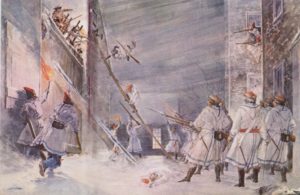On June 27, 1775, General George Washington and his Continental Army invaded Canada in an attempt to conquer Quebec. British reinforcements came up the St. Lawrence in May 1776, and the Battle of Trois-Rivières turned into a disaster for the Americans. The army withdrew to Ticonderoga. Although some help was given to the Americans by the locals, Governor Carleton punished American sympathizers, and public support of the American cause came to an end. In 1778, Frederick Haldimand took over for Guy Carleton as governor of Quebec.

The arrival of 10,000 Loyalists at Quebec in 1784 destroyed the political balance that Haldimand (and Carleton before him) had worked so hard to achieve. The swelling numbers of English encouraged them to make greater demands for recognition with the colonial government. To restore stability to his largest remaining North American colony, King George III sent Carleton back to Quebec to remedy the situation.
In ten years, Quebec had undergone a dramatic change. What worked for Carleton in 1774 was not likely to succeed in 1784. Specifically, there was no possibility of restoring the previous political balance – there were simply too many English people unwilling to reach a compromise with the 145,000 Canadiens or their colonial governor. The situation called for a more creative approach to problem solving.
Separation of the Province of Quebec:
Loyalists soon petitioned the government to be allowed to use the British legal system they were used to in the American colonies. The creation of Upper and Lower Canada in 1791 allowed most Loyalists to live under British laws and institutions, while the French-speaking population of Lower Canada could maintain their familiar French civil law and the Catholic religion. Therefore, Governor Haldimand (at the suggestion of Carleton) drew Loyalists away from Quebec City and Montreal by offering free land on the northern shore of Lake Ontario to anyone willing to swear allegiance to George III. The Loyalists were thus given land grants of 200 acres per person. Basically, this approach was designed with the intent of keeping French and English as far apart as possible. Therefore, after the separation of the Province of Quebec, Lower Canada and Upper Canada were formed, each with its own government.
Rebellion in Lower Canada:
In 1837, residents of Lower Canada – led by Louis-Joseph Papineau and Robert Nelson – formed an armed resistance group to seek an end to the unilateral control of the British governors. They made a Declaration of Rights with equality for all citizens without discrimination and a Declaration of Independence of Lower Canada in 1838. Their actions resulted in rebellions in both Lower and Upper Canada. An unprepared British Army had to raise militia force; the rebel forces scored a victory in Saint-Denis but were soon defeated.
After the rebellions, Lord Durham was asked to undertake a study and prepare a report on the matter and to offer a solution for the British Parliament to assess. Following Durham’s report, the British government merged the two colonial provinces into one Province of Canada in 1840 with the Act of Union. The two colonies remained distinct in administration, election, and law.
